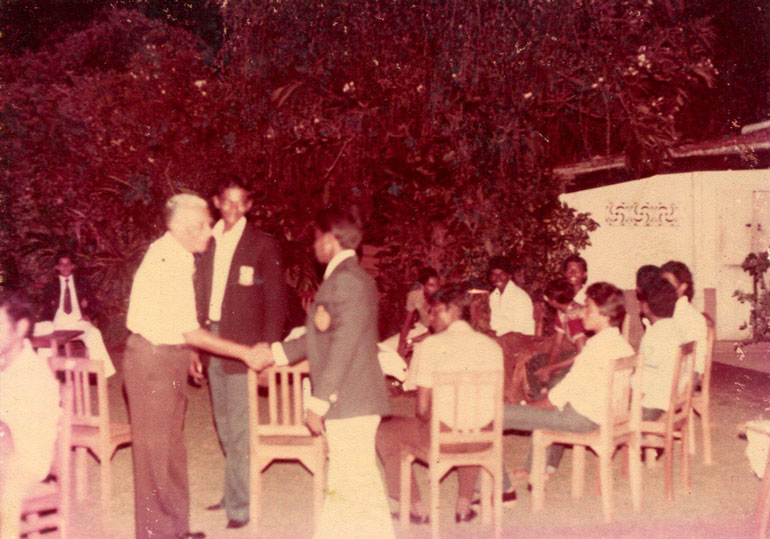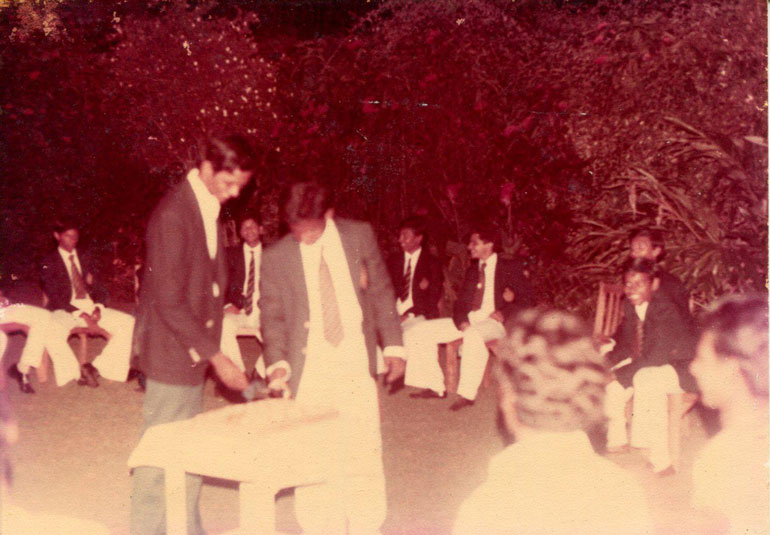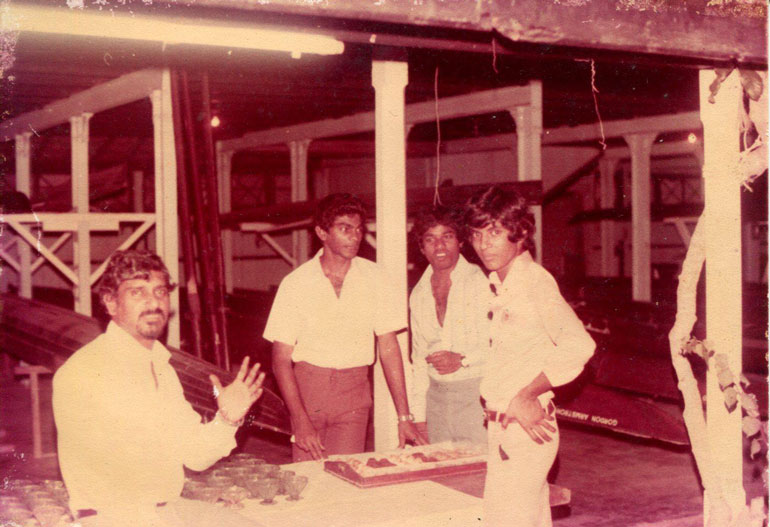Monday Jan 13, 2025
Monday Jan 13, 2025
Saturday, 31 October 2015 00:00 - - {{hitsCtrl.values.hits}}

The Royal Captain being introduced to the Warden STC, at th e tea party

The two captains Faheem Moheed of STC and Nilu Philips of Royal cutting the cake 
The organisers of the tea party, late Chula Samarasinghe, Rohan Fernando, late Vijitha Parakrama and late Rabin Samuel
By Rohan Fernando
An event that began as a boat race between two schools in 1962 has today evolved into a fully-fledged regatta looked forward to by all rowing enthusiasts. The two schools, Royal and S. Thomas’ since 1962 have met on the Beira waters, annually on 45 occasions, with two gaps in between.
My story and memory goes back to the period it stalled first in 1973 until 1979. The unexpected halt to the rowing activities of Royal College occurred due to a dispute, the school had with the Colombo Rowing Club over the suspension of their coach following a complaint by a committee member of the Club. The relatively minor incident which could have been resolved, ballooned out of proportion to curtail rowing activities of Royal College for a long time and the suspension of the annual encounter from 1973 to 1979.
Thomians kept at practices ever-hopeful of a revival whilst taking part in regattas organised by the CRC. I was amongst the hopefuls who continued rowing since joining the Thomian squad in the middle of 1971 as a rookie not knowing the difference between a boat and an oar. The desire of any budding Thomian was to take part in a Royal-Thomian encounter but it was not my turn as a raw recruit in 1971 and 1972 and eluded my chance of ever rowing in a Royal-Thomian regatta.
CRC being the only Rowing facility with equipment, all had to obey the rules and regulations enforced by the club and the strong stand taken by both Royal and CRC dragged on for far too long to spoil the enthusiasm and passion of the young oarsmen of that era.
It was this disappointment which challenged me later on and strengthened my resolve to revive this great sporting event. Having joined CRC as an active member in 1975 I was elected Vice Captain in 1978 with late Chula Samarasinghe as the Captain of boats. We immediately got into the process of mediation and getting Royal crews back in action.
The Thomians never stopped rowing coached by Ajith Gunawardena and Lloyd Sirimanne on the old English style of power strokes with bell-notes and leaning back to ease the oar handle. The Royalists were somewhat lost without a dedicated coach until Chula Samarasinghe in 1980 took them under his wings.
In 1980 when I was elected Captain of boats with Eraj Wijesinghe, a past Royal oarsman of repute as the president of the club, we finally got the opportunity to get both sides especially the Royalists to agree on a date to reactivate the Royal-Thomian regatta. The courageous Royal crew led by Nilu Philips took the plunge even as underdogs in true sporting spirit to take on the Thomians. It must be recorded for posterity that the regatta got its life back due to relentless persuasive action by a few rowing diehards from Royal College and S. Thomas’ and the courage of the Royal freshman of 1980 to face a formidable challenge, come what may.
The equipment available at that time were ancient, heavy and leaking. The oars were narrow wooden blades often referred to as “matchsticks”, imported several years ago from Aylings of England. Two clinker fours “Basil Drakeford” and “Gordon Armstrong” were allocated for training and racing. These boats invariably became heavier in mid-stream and required emptying, every time it reached the landing stage.
The coxed pairs allocated for the event were wooden clinkers built by a local boatyard, TAOS and aptly named T1 and T2. They were heavy boats, made out of local Teak wood, floated solidly on the water and required a platoon of men to launch and lift-off. The single Sculls too were wooden clinkers named S1 and S2 imported from England long years back but kept in prime condition by the CRC carpenters.
The slides or the moving seats of all boats had a frustrating mechanism combining four units of solid brass wheels in pairs moving the seat on wooden guide rails. The system broke down often when awkward movements of the crew derailed the seat. These were the tough conditions under which the oarsmen of yesteryear fought on the water in total contrast to the abundantly available, sleek, feather-light equipment of today.
A few days before the great event a worrisome situation arose as the boat-boys alerted me to the depleting stock of oars due to breakages as a result of extraordinary power strokes by the Thomian engine room with particular accusation aimed at Thomian no. 2 Asanga Perera. A few days before the races, we were down to nine sweep oars for the fours and pairs events. Eight oars were in OK status but the ninth oar had a crack at the button and was in the cast with the usual araldite treatment. Kulatilake and Wilson the two genius carpenters cum boat boys assured me of the oar being cured to operational strength in time for the races.
As the Captain of boats of CRC and the person in charge of the regatta, I had to issue strictures to avoid a subsequent dispute in the likely event of a crew ending up with a broken oar before the start and thereby spoiling the spirit of revival.
As well-known to most rowers of yesteryear, my PR skills were not the best and in a very strong tone I warned both crews not to damage any more oars or else the oarsmen responsible for the breakage would be given the recuperating oar with the button changed to bow or stroke side. I am glad it worked and we conducted the revival regatta without serious breakages or adverse incidents. The result of the event which I will not elaborate on is immaterial but to my conscience Rowing won the day and it certainly revived not only the Royal-Thomian but the sport of rowing to develop and propagate to a level we are all excited to witness today.
A high level of camaraderie prevailed throughout preparation stage and during the regatta with vociferous Royal captain Nilu Philips and the mild-mannered Thomian Captain Faheem Moheed understanding the great responsibility thrust upon them in competing at a Royal Thomian regatta after a lapse of seven years.
A tea party was hosted on the club lawn by ardent CRC members, day before the event. A specially baked cake was cut by both captains to commemorate the revival. Some of the members who actively participated were pavilion members, Ananda Amerasekera, Mackey and Rabin Samuel, their wives and of course the amiable Thomian Boxer, Vijitha Parakrama together with Chula and myself.
All males mentioned here have exited the worldly abode and I remain to write the story. It is proper and an act of graciousness to remember these gentlemen and all those who helped in the revival process at a time Rowing was just a nominal sport in the national and school sporting calendars.
What propelled rowing to the giddy heights we are lucky to witness today, from a motley crew of students from two schools and the Colombo University in the 1980s to 18 institutions and more than 500 active oarsmen and oarswomen in present day?
Young blood from the two leading schools created the ideal talent pool to draft mature rowers to the CRC to continue the Club’s rowing calendar involving local and international Rowing encounters. It is correct to state that this singular incident of revival of the Royal Thomian regatta made such an impact in the progression of the sport.
The bonding of athletes from different strata and continuing friendships even beyond school days led to a strong rowing fraternity built on sports ethics and high level of discipline which most others speak of with envy. Some of the revival oarsmen of 1980 have made an indelible mark in my memory. They are Suren de Silva, Lochi de Mel, Nalin Cooke and Kavan Ratnayake to name a few.
Though disappointed not being able to row the Royal Thomian regatta at school, I am yet proud to be associated with this great sport and be a link in the chain of events which led to the revival and for the regatta to be conducted continuously with the 50th encounter just four years away.
Disce-aut-discede.
Esto Perpetua.